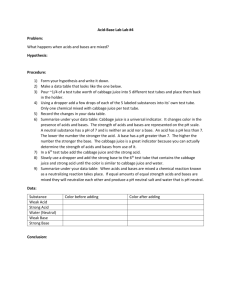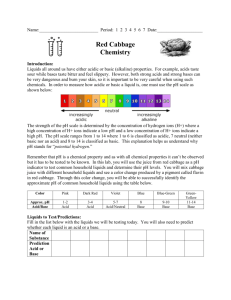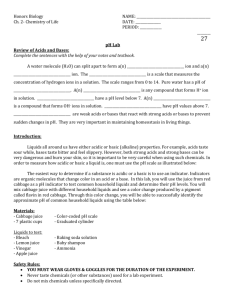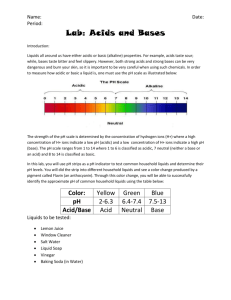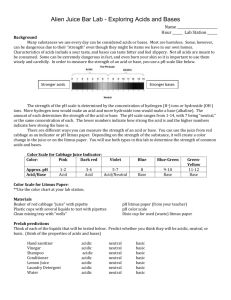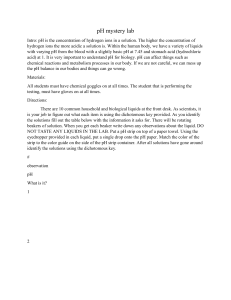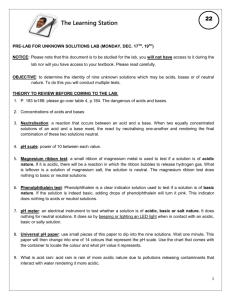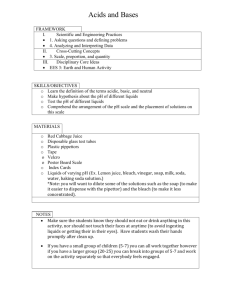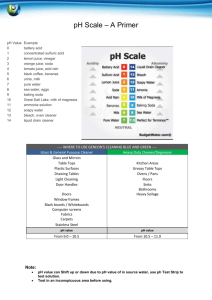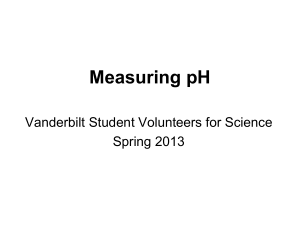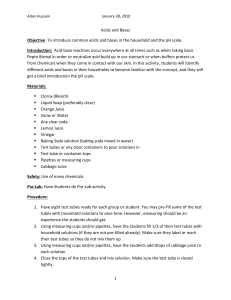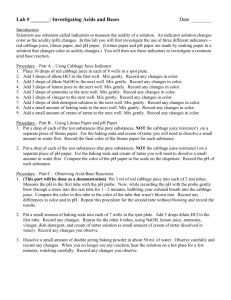Skip this step – It`s done in the video
advertisement
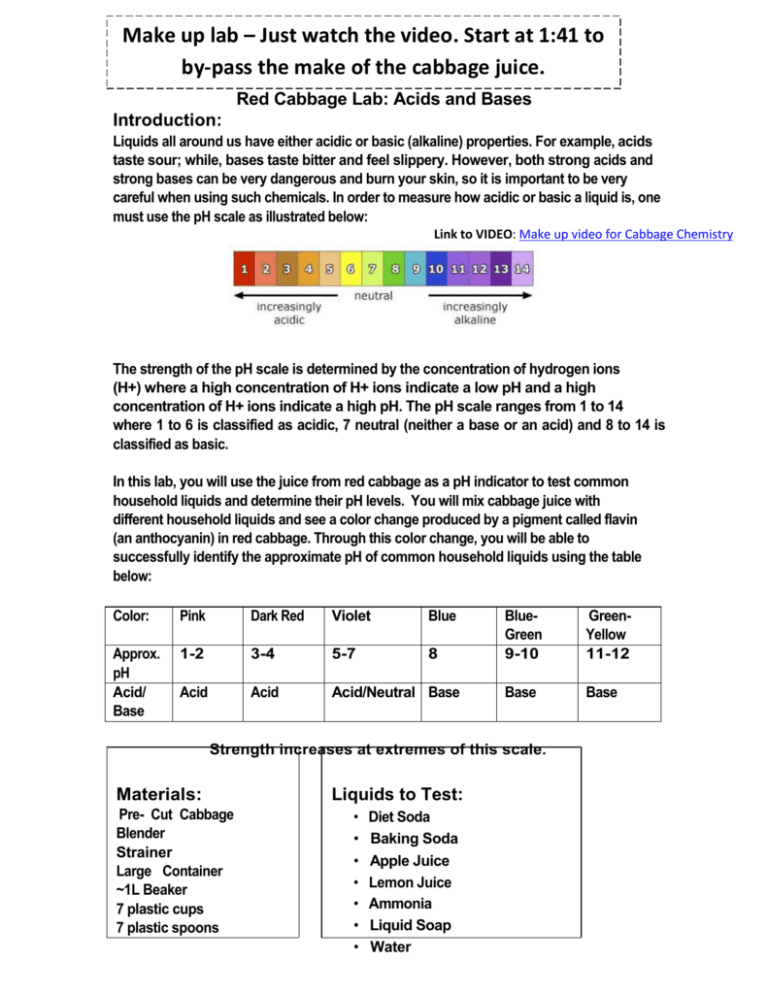
Make up lab – Just watch the video. Start at 1:41 to by-pass the make of the cabbage juice. Red Cabbage Lab: Acids and Bases Introduction: Liquids all around us have either acidic or basic (alkaline) properties. For example, acids taste sour; while, bases taste bitter and feel slippery. However, both strong acids and strong bases can be very dangerous and burn your skin, so it is important to be very careful when using such chemicals. In order to measure how acidic or basic a liquid is, one must use the pH scale as illustrated below: Link to VIDEO: Make up video for Cabbage Chemistry The strength of the pH scale is determined by the concentration of hydrogen ions (H+) where a high concentration of H+ ions indicate a low pH and a high concentration of H+ ions indicate a high pH. The pH scale ranges from 1 to 14 where 1 to 6 is classified as acidic, 7 neutral (neither a base or an acid) and 8 to 14 is classified as basic. In this lab, you will use the juice from red cabbage as a pH indicator to test common household liquids and determine their pH levels. You will mix cabbage juice with different household liquids and see a color change produced by a pigment called flavin (an anthocyanin) in red cabbage. Through this color change, you will be able to successfully identify the approximate pH of common household liquids using the table below: Color: Pink Dark Red Violet Blue Approx. pH Acid/ Base 1-2 3-4 5-7 8 Acid Acid Acid/Neutral Base BlueGreen 9-10 GreenYellow 11-12 Base Base Strength increases at extremes of this scale. Materials: Pre- Cut Cabbage Blender Strainer Large Container ~1L Beaker 7 plastic cups 7 plastic spoons Liquids to Test: • • • • • • • Diet Soda Baking Soda Apple Juice Lemon Juice Ammonia Liquid Soap Water Pre-Laboratory Predictions: Look at each of the liquids being tested. Predict whether each of the substances is acidic, neutral or basic. Circle one. (Think about the properties of acids and bases.) Diet soda Acidic Neutral Basic Baking Soda Acidic Neutral Basic Apple Juice Acidic Neutral Basic Lemon Juice Acidic Neutral Basic Ammonia Acidic Neutral Basic Liquid Soap Acidic Neutral Basic Water Acidic Neutral Basic Instructions: Skip this step – It’s done in the video Preparing the Cabbage Juice: 1. Put the red cabbage leaves into the blender with 800mL of water. 2. Close the top and let it blend at high power for 30 seconds. 3. Once it is blended, filter out the leaves inside the mixture with the strainer and pour the mixture into a large container. *This should provide you with 600-800 ml of cabbage juice. Mixing the Cabbage Juice: 4. Label each cup with each of the liquids. (Example: vinegar, apple juice, etc.) 5. Pour 100 ml of each individual liquid into its respective cup (except for baking soda). 6. For baking soda, add 3 tablespoons of baking soda into 100 ml water. Example: 7. Pour 50 ml of cabbage juice into each of the cups. Do this one at a time and record the color change below: Watch Video and pay close attention to the color change. The color change indicates the pH. This starts at 2:04 in the video. Liquid: Color Change/ pH Actual pH Diet Soda Baking Soda Apple Juice Lemon Juice Ammonia Liquid Soap Water – neutral - control Now look up the actual pH of each of the substances and see how accurate the cabbage juice indicator was! How did your reasoning for your predictions change after seeing the approximate pH level? 8. Categorize your results below: Strong Acids Weak Acids Neutral Weak Bases Strong Bases Ex: Lemon Juice – pH of 2 (pink) Now add 10 tablespoons m o r e of baking soda into a new cup. Skip this step – It’s done in the video Does the color intensity of the liquid change? If so, how and why do you think this is? (Hint: think in terms of pH) Concept Questions: 1. Does the addition of water (baking soda +water) alter the pH of weak acids/bases? How does it change the pH of strong acids/bases? Why or why not? 2. How does a difference in 1 pH unit change in terms of H+ concentration? Example: How does a pH of 3 differ from pH of 4? Which one is stronger or weaker? Why? 3. Look at the liquid you tested. Which the liquids had the highest pH level? Real Life Applications: 1. Neutralization: Whenever you mix an acid with a base, they neutralize each other. If this is the case, why is Alka- Seltzer used to treat stomach aches? (Note: excess stomach acids cause stomach aches) 2. Acid Rain: What is acid rain and how is it a problem to oceans, rivers, lakes, ponds ect.?
